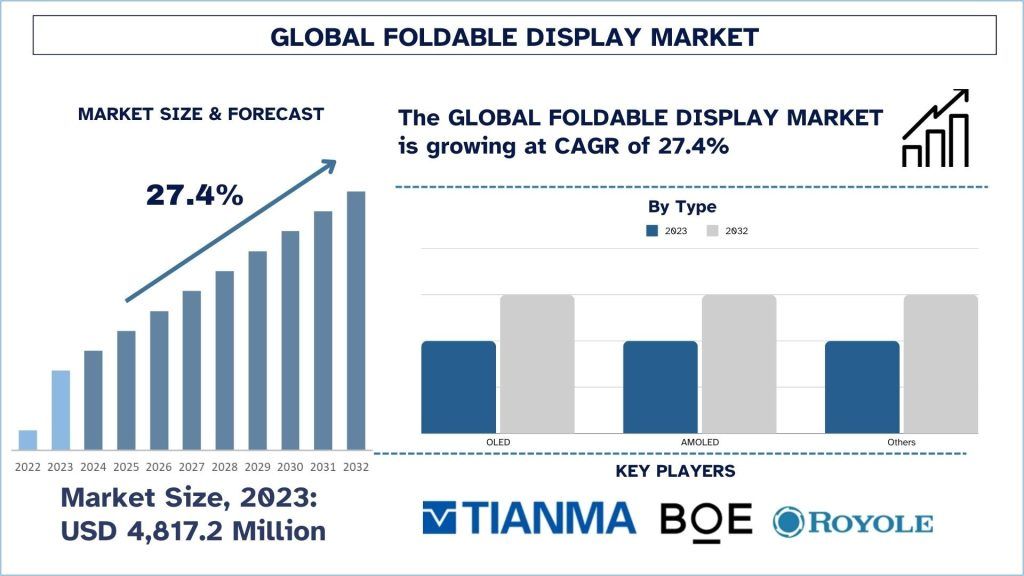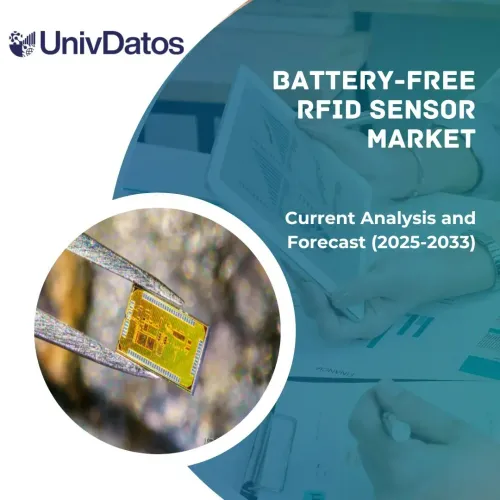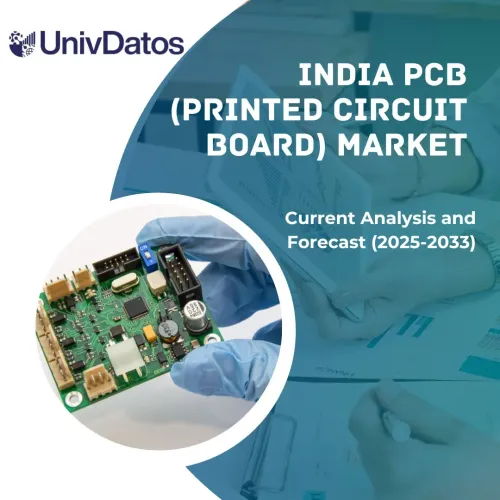- Startseite
- Über uns
- Industrie
- Dienstleistungen
- Lesen
- Kontaktieren Sie uns
Markt für faltbare Displays: Aktuelle Analyse und Prognose (2024-2032)
Betonung auf Typ (OLED, AMOLED und andere); Anwendung (Smartphone-Display, Tablets und Notebooks, Fernseher, Wearable-Display und andere); Region/Land.
Marktgröße & Prognose für faltbare Displays
Der Markt für faltbare Displays wurde 2023 auf 4.817,2 Millionen USD geschätzt und wird voraussichtlich mit einer starken CAGR von rund 27,4 % im Prognosezeitraum (2024-2032) wachsen, was auf die zunehmende Nutzung in der Unterhaltungselektronik zurückzuführen ist.
Marktanalyse für faltbare Displays
Der Markt für faltbare Displays hat in letzter Zeit dank wichtiger Entwicklungen in den Technologien für faltbare Displays wie OLED und AMOLED ein verstärktes Wachstum gezeigt. Ein faltbares Display ist eine Bildschirm-Innovation in der Technologie, die es Mobiltelefonen, Tablets und Laptops ermöglicht, sich so zu falten, dass Kunden eine große Bildschirmgröße in einem kleinen tragbaren Gerät erhalten. Die wichtigsten Triebkräfte des Marktes sind die steigende Nachfrage nach neuen Geräten, der Bedarf an größeren Displays auf Mobilgeräten und der Bedarf an besseren Erfahrungen. Darüber hinaus hat auch die Einführung der 5G-Technologie den Markt im Laufe der Zeit begünstigt, da das faltbare Gerät das Potenzial hat, die Effizienz der Hochgeschwindigkeitsfunktion von 5G zu steigern.
Angetrieben vom bedeutenden Markt für faltbare Displays boomt der asiatisch-pazifische Raum, vor allem China, Südkorea und Japan, sowohl aufgrund der robusten Nachfrage nach Premium-Smartphones als auch aufgrund der ausgeprägten Fertigungsfähigkeiten, die die Akzeptanz beschleunigen. Um Unternehmen zu unterstützen, die Displays der nächsten Generation herstellen, hat die chinesische Regierung verschiedene Initiativen wie Subventionen und Steuersenkungen gestartet. Darüber hinaus erleben die US-amerikanischen und europäischen Märkte ein beschleunigtes Wachstum, das durch staatliche Zuschüsse und Forschungs- und Entwicklungs-Steuergutschriften unterstützt wird, die lokale Technologieunternehmen bei der Herstellung flexibler Displays unterstützen. Die Investitionen dieser Länder in Technologie und Infrastruktur werden wahrscheinlich in absehbarer Zukunft zu einer starken Expansion auf dem Markt für faltbare Displays führen.
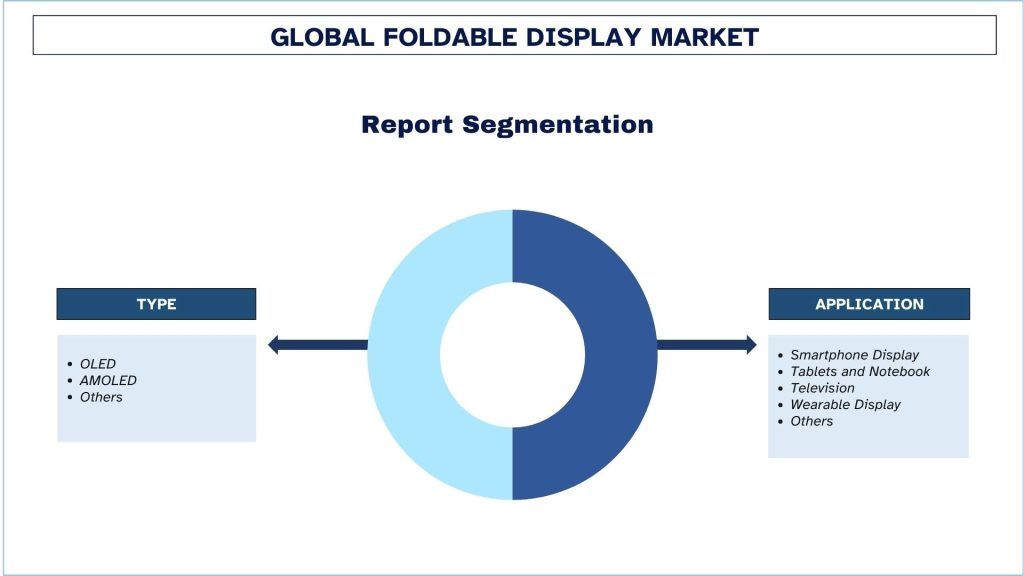
Markttrends für faltbare Displays
Dieser Abschnitt erörtert die wichtigsten Markttrends, die die verschiedenen Segmente des Marktes für faltbare Displays beeinflussen, wie von unserem Team von Forschungsexperten identifiziert.
Wachsende Verbrauchernachfrage nach multifunktionalen Geräten
Kunden suchen nach tragbareren Lösungen und erwarten gleichzeitig größere Bildschirmgrößen. Jedes der faltbaren Displays bietet den Komfort, ein Smartphone zu halten, und ermöglicht gleichzeitig die „Magie“ des Umschaltens auf einen größeren Bildschirm, wie im Fall eines Tablets oder eines kleinen Notebooks. Diese Nachfrage ist besonders im Smartphone-Sektor zu spüren, wo Verbraucher nach Geräten suchen, die in der Lage sind, andere Aktivitäten wie Video-Streaming, Spiele und Remote-Arbeit auszuführen.
Beispiel: Einer dieser Treiber ist die Samsung Galaxy Z Fold-Serie. Huawei verwendet auch einen faltbaren Abschnitt, der wie ein Mini-Telefon funktioniert, wenn er geschlossen ist, und einen größeren Bildschirm in Tablet-Größe, wenn er geöffnet ist – nützlich für alle, die ein kleines, leicht zu transportierendes Mobilteil benötigen, aber auch einen großen Bildschirm für die Arbeit, Spiele oder einfach nur zum Ansehen von Videos.
Fortschritte in der OLED- und AMOLED-Technologie
Sowohl die OLED- als auch die AMOLED-Technologie bilden die Grundlage für flexible und dünne faltbare Displays, da sie den zusätzlichen Vorteil einer hervorragenden Auflösung und Bildqualität bieten. Diese Technologien ermöglichen es dem Bildschirm, sich zu biegen, zu falten und sogar zu rollen, ohne die Bildqualität oder Lebensdauer der Bildschirme zu beeinträchtigen. Außerdem bieten AMOLED-Displays einen besseren Kontrast, hohe Bildwiederholraten und Energieeffizienz, was für faltbare Telefone geeignet ist.
Beispiel: Das Unternehmen hat stark in flexible OLED-Panels investiert, wodurch LG Display neue faltbare Lösungen über Smartphones hinaus entwickelt hat, darunter Laptops und Auto-Mobilitätskonzepte. So verwendet der LG Rollable TV diese Technologie, indem er sich in einen Sockel rollt, um die Vielseitigkeit und Kreativität zu demonstrieren, die OLED bietet.
Erhöhte Investitionen der OEMs
Original Equipment Manufacturers (OEMs) investieren stark in die Forschung und Entwicklung von faltbarer Display-Technologie. Unternehmen wie Samsung, Huawei, Xiaomi und andere sind führend auf dem Markt, indem sie ständig die Grenzen dessen erweitern, was faltbare Displays erreichen können. Diese intensiven Investitionen treiben Innovationen voran, senken die Kosten im Laufe der Zeit und erhöhen die Verfügbarkeit faltbarer Geräte auf dem Verbrauchermarkt.
Beispiel: Die Mate X-Serie von Huawei stellt eine bedeutende Investition in die faltbare Technologie dar, wobei sich das Unternehmen auf die Verbesserung des Scharnierdesigns und der Display-Haltbarkeit konzentriert hat, um mit anderen Angeboten für faltbare Smartphones zu konkurrieren. Diese Investition ermöglicht es ihnen, Premium-faltbare Smartphones mit wettbewerbsfähigen Funktionen und Leistungen anzubieten.
APAC wird voraussichtlich während des Prognosezeitraums mit einer signifikanten CAGR wachsen
In Bezug auf die geografische Aufteilung wird der größte Anteil der faltbaren Displays vom asiatisch-pazifischen Raum (APAC) dominiert, hauptsächlich aufgrund seines Status als globales Zentrum der Elektronikfertigung und Innovationszentrum. Die Flexibilitäten eines faltbaren Displays werden weiter nach seiner Bildschirmkrümmung differenziert, z. B. in Bezug auf konvexe und konkave Typen. Um die Nachfrage nach solchen Flexibilitäten zu befriedigen, sind Akteure mit starken Fertigungsinfrastrukturen wie Südkorea, China und Japan eng im APAC-Raum positioniert, während wichtige Akteure wie Samsung Display, LG Display und BOE Technology Group in dieser Region ihren Hauptsitz haben, wobei erstere die wichtigsten Entwickler der flexiblen OLED- und AMOLED-Technologie waren. Dies generiert eine starke Nachfrage nach Premium-Geräten der Spitzenklasse in den Ländern und hat sich durch die weit verbreitete Einführung der 5G-Technologie weiter beschleunigt. Darüber hinaus hat die Region eine starke Lieferkette aufgebaut und an bedeutenden Forschungs- und Entwicklungsinitiativen gearbeitet, was faltbare Displays zu einem schnell wachsenden Bereich unter Anwendungen wie Smartphones, Laptops und Automobilen macht.
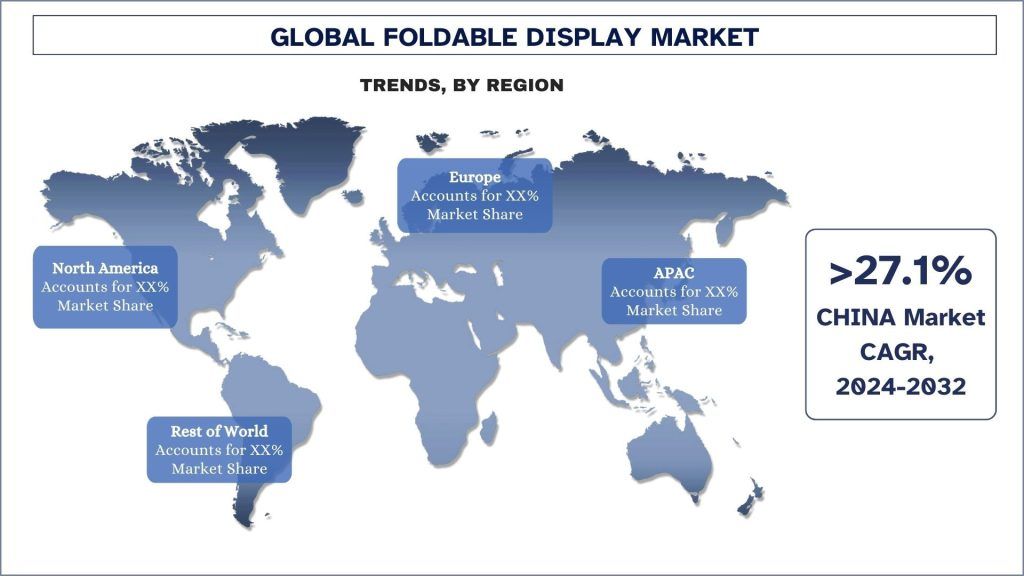
Branchenübersicht für faltbare Displays
Der Markt für faltbare Displays ist wettbewerbsintensiv und fragmentiert, mit der Präsenz mehrerer globaler und internationaler Marktteilnehmer. Die wichtigsten Akteure verfolgen verschiedene Wachstumsstrategien, um ihre Marktpräsenz zu verbessern, wie z. B. Partnerschaften, Vereinbarungen, Kooperationen, Produkteinführungen, geografische Expansionen sowie Fusionen und Übernahmen. Zu den wichtigsten Akteuren auf dem Markt gehören Samsung Display, LG Display, BOE Technology Group, Royole Corporation, Visionox Company, TCL Corporation, Tianma Micro-electronics, Sharp Corporation, Everdisplay Optronics (Shanghai) Co., Ltd. und AUO Corporation.
Markt für faltbare Displays – Nachrichten
Im Januar 2023 wird Samsung Display Co. in Südkorea etwa 1,8 Milliarden US-Dollar in eine Fabrik im Norden Vietnams investieren, um OLED-Displays für Fahrzeuge und Tech-Produkte herzustellen.
Im März 2024 gab LG Display seine Absicht bekannt, 1,2925 Billionen Won (971 Millionen US-Dollar) durch eine Kapitalerhöhung zu beschaffen, die es dann in sein OLED-Geschäft investieren wird, um die wachsende Nachfrage nach führenden Display-Produkten zu befriedigen.
Marktbericht für faltbare Displays – Berichterstattung
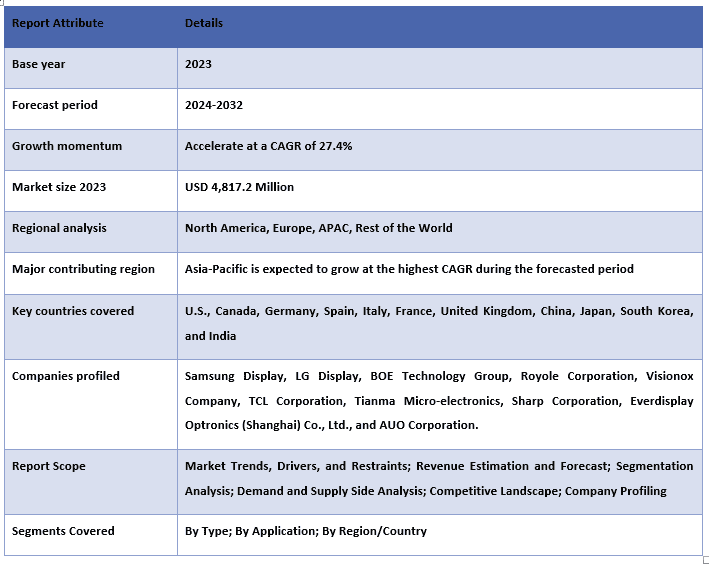
Gründe für den Kauf dieses Berichts:
- Die Studie umfasst Marktabschätzungen und Prognoseanalysen, die von authentifizierten Branchenexperten validiert wurden.
- Der Bericht bietet auf einen Blick eine kurze Übersicht über die Gesamtleistung der Branche.
- Der Bericht enthält eine eingehende Analyse prominenter Branchenkollegen mit Schwerpunkt auf wichtigen Geschäftsfinanzen, Produktportfolios, Expansionsstrategien und aktuellen Entwicklungen.
- Detaillierte Untersuchung von Treibern, Einschränkungen, wichtigen Trends und Chancen, die in der Branche vorherrschen.
- Die Studie umfasst den Markt umfassend über verschiedene Segmente hinweg.
- Detaillierte Analyse der Branche auf regionaler Ebene.
Anpassungsoptionen:
Der globale Markt für faltbare Displays kann weiter an die Anforderungen oder jedes andere Marktsegment angepasst werden. Darüber hinaus versteht UMI, dass Sie möglicherweise Ihre eigenen Geschäftsanforderungen haben. Zögern Sie daher nicht, uns zu kontaktieren, um einen Bericht zu erhalten, der Ihren Anforderungen vollständig entspricht.
Inhaltsverzeichnis
Forschungsmethodik für die Marktanalyse für faltbare Displays (2024-2032)
Die Analyse des historischen Marktes, die Schätzung des aktuellen Marktes und die Prognose des zukünftigen Marktes für globale faltbare Displays waren die drei Hauptschritte zur Erstellung und Erforschung der Einführung von faltbaren Displays in wichtigen Regionen weltweit. Um die historischen Marktzahlen zu sammeln und die aktuelle Marktgröße zu schätzen, wurden umfassende Sekundärrecherchen durchgeführt. Zweitens wurden zahlreiche Erkenntnisse und Annahmen berücksichtigt, um diese Erkenntnisse zu validieren. Darüber hinaus wurden umfassende Primärinterviews mit Branchenexperten entlang der Wertschöpfungskette des globalen Marktes für faltbare Displays durchgeführt. Nach der Annahme und Validierung der Marktzahlen durch Primärinterviews wandten wir einen Top-Down-/Bottom-Up-Ansatz an, um die vollständige Marktgröße zu prognostizieren. Danach wurden Marktaufschlüsselungs- und Datentriangulationsmethoden angewendet, um die Marktgröße der Segmente und Untersegmente der Branche zu schätzen und zu analysieren. Die detaillierte Methodik wird im Folgenden erläutert:
Analyse der historischen Marktgröße
Schritt 1: Ausführliche Studie von Sekundärquellen:
Eine detaillierte Sekundärstudie wurde durchgeführt, um die historische Marktgröße für faltbare Displays über unternehmensinterne Quellen wie Jahresberichte & Finanzberichte, Leistungspräsentationen, Pressemitteilungen usw. sowie externe Quellen wie Zeitschriften, Nachrichten & Artikel, Veröffentlichungen der Regierung, Veröffentlichungen von Wettbewerbern, Branchenberichte, Datenbanken von Drittanbietern und andere glaubwürdige Veröffentlichungen zu erhalten.
Schritt 2: Marktsegmentierung:
Nachdem wir die historische Marktgröße für faltbare Displays erhalten hatten, führten wir eine detaillierte Sekundäranalyse durch, um historische Markteinblicke und -anteile für verschiedene Segmente und Untersegmente für wichtige Regionen zu sammeln. Wichtige Segmente sind in dem Bericht enthalten, wie z. B. Typ und Anwendung. Darüber hinaus wurden Länderanalysen durchgeführt, um die Gesamtakzeptanz von Testmodellen in dieser Region zu bewerten.
Schritt 3: Faktor-Analyse:
Nachdem wir die historische Marktgröße der verschiedenen Segmente und Untersegmente ermittelt hatten, führten wir eine detaillierte Faktorenanalyse durch, um die aktuelle Marktgröße für faltbare Displays zu schätzen. Darüber hinaus führten wir eine Faktorenanalyse unter Verwendung abhängiger und unabhängiger Variablen wie Typ und Anwendung des Marktes für faltbare Displays durch. Eine gründliche Analyse wurde von Angebots- und Nachfrageszenarien unter Berücksichtigung der wichtigsten Partnerschaften, Fusionen und Übernahmen, Geschäftserweiterungen und Produkteinführungen im Sektor für faltbare Displays auf der ganzen Welt durchgeführt.
Schätzung & Prognose der aktuellen Marktgröße
Aktuelle Marktgrößenbestimmung: Basierend auf umsetzbaren Erkenntnissen aus den obigen 3 Schritten kamen wir zu der aktuellen Marktgröße, den wichtigsten Akteuren auf dem globalen Markt für faltbare Displays und den Marktanteilen der Segmente. Alle erforderlichen prozentualen Anteile, Aufteilungen und Marktunterteilungen wurden unter Verwendung des oben genannten Sekundäransatzes ermittelt und durch Primärinterviews verifiziert.
Schätzung & Prognose: Für die Marktschätzung und -prognose wurden verschiedenen Faktoren Gewichte zugewiesen, darunter Treiber und Trends, Einschränkungen und Chancen für die Stakeholder. Nach der Analyse dieser Faktoren wurden relevante Prognosetechniken, d. h. der Top-Down-/Bottom-Up-Ansatz, angewendet, um zur Marktprognose für 2032 für verschiedene Segmente und Untersegmente in den wichtigsten Märkten weltweit zu gelangen. Die zur Schätzung der Marktgröße angewandte Forschungsmethodik umfasst:
Die Marktgröße der Branche, gemessen am Umsatz (USD), und die Akzeptanzrate des Foldable Display in den wichtigsten Märkten im Inland
Alle prozentualen Anteile, Aufteilungen und Aufschlüsselungen von Marktsegmenten und -untersegmenten
Hauptakteure im globalen Foldable Display-Markt in Bezug auf die angebotenen Produkte. Außerdem die Wachstumsstrategien, die diese Akteure anwenden, um im schnell wachsenden Markt zu konkurrieren
Validierung von Marktgröße und -anteil
Primärforschung: Es wurden eingehende Interviews mit den Key Opinion Leadern (KOLs) geführt, einschließlich Führungskräften der obersten Ebene (CXO/VPs, Vertriebsleiter, Marketingleiter, Betriebsleiter, Regionalleiter, Länderleiter usw.) in den wichtigsten Regionen. Die Ergebnisse der Primärforschung wurden dann zusammengefasst und eine statistische Analyse durchgeführt, um die aufgestellte Hypothese zu belegen. Die Erkenntnisse aus der Primärforschung wurden mit den Sekundärfunden konsolidiert, wodurch Informationen in umsetzbare Erkenntnisse umgewandelt wurden.
Aufteilung der primären Teilnehmer in verschiedenen Regionen
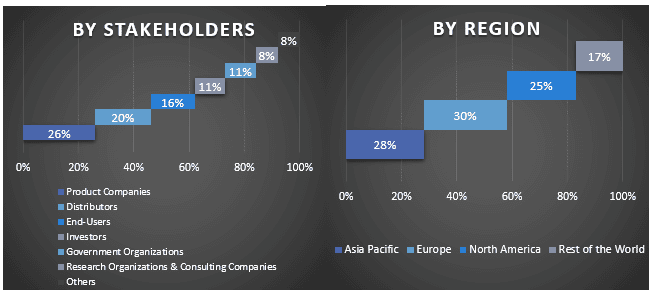
Markt Engineering
Die Daten-Triangulationstechnik wurde eingesetzt, um die Gesamtmarktschätzung abzuschließen und präzise statistische Zahlen für jedes Segment und Untersegment des globalen Foldable Display-Marktes zu erhalten. Die Daten wurden nach der Untersuchung verschiedener Parameter und Trends in den Bereichen Typ und Anwendung im globalen Foldable Display-Markt in mehrere Segmente und Untersegmente aufgeteilt.
Das Hauptziel der Global Foldable Display Market Study
Die aktuellen und zukünftigen Markttrends des globalen Foldable Display-Marktes wurden in der Studie herausgearbeitet. Investoren können strategische Erkenntnisse gewinnen, um ihre Entscheidungen für Investitionen auf der Grundlage der in der Studie durchgeführten qualitativen und quantitativen Analysen zu treffen. Aktuelle und zukünftige Markttrends bestimmten die Gesamtattraktivität des Marktes auf regionaler Ebene und boten den Industrieteilnehmern eine Plattform, um den unerschlossenen Markt zu nutzen und von einem First-Mover-Vorteil zu profitieren. Weitere quantitative Ziele der Studien umfassen:
- Analyse der aktuellen und prognostizierten Marktgröße der Foldable Display-Industrie in Bezug auf den Wert (USD). Außerdem Analyse der aktuellen und prognostizierten Marktgröße verschiedener Segmente und Untersegmente
- Zu den Segmenten in der Studie gehören die Bereiche Typ und Anwendung
- Definition und Analyse des regulatorischen Rahmens für die Foldable Display-Industrie
- Analyse der Wertschöpfungskette, die mit der Präsenz verschiedener Intermediäre verbunden ist, zusammen mit der Analyse des Kunden- und Wettbewerbsverhaltens der Branche
- Analyse der aktuellen und prognostizierten Marktgröße des Foldable Display-Marktes für die Hauptregion
- Zu den wichtigsten Ländern der in dem Bericht untersuchten Regionen gehören der asiatisch-pazifische Raum, Europa, Nordamerika und der Rest der Welt
- Unternehmensprofile des Foldable Display-Marktes und die Wachstumsstrategien, die von den Marktteilnehmern angewendet werden, um sich in dem schnell wachsenden Markt zu behaupten
- Detaillierte Analyse der Branche auf regionaler Ebene
Häufig gestellte Fragen FAQs
Q1: Wie groß ist die aktuelle Marktgröße und das Wachstumspotenzial des Marktes für faltbare Displays?
Q2: Was sind die treibenden Faktoren für das Wachstum des Marktes für faltbare Displays?
Q3: Welches Segment hat den größten Anteil am Markt für faltbare Displays nach Typ?
Q4: Was sind die aufkommenden Technologien und Trends im Markt für faltbare Displays?
Q5: Welche Region wird den Markt für faltbare Displays dominieren?
Verwandt Berichte
Kunden, die diesen Artikel gekauft haben, kauften auch

